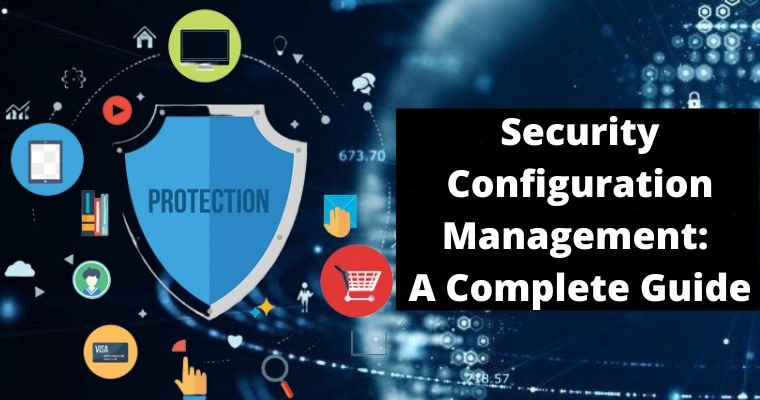In this article, we will discuss Security Configuration Management and how it works.
Modern companies face two major problems:
- minimizing the risk of network security.
- Compliance with regulations made by either industry or government.
As cyber-attacks increased, Cybersecurity became the first thing the company did take care of, Because data is an essential thing in today’s world. No matter what you are doing, data always remains an essential thing.
If you are a company, then protecting the data of employees and customers remains your primary motive to work smoothly.
If you are an individual, keeping your information safe from cyber-attacks enables you to live a tension-free life. You won’t get tense about things like knowing about my personal information; someone will blackmail me, etc.
Table of Contents
What is Security Configuration Management?
Security configuration management is a process to reduce attacks on networks by continuously hardening the security configuration of devices, systems, and applications.
With this, security configuration compliance also helps you to enable compliance auditors to monitor compliance with policies.
There are two objectives that any company wants to achieve through Security Configuration management.
Those two objectives are:
● Achieve compliance with policies of either industries or government.
Governments of every country make policies regarding every sector of the economy. If the company accepts those policies and works accordingly, it can prove beneficial to the company.
The company can work more smoothly if it works according to the policies made by industry and government.
Let’s take an example of this. Suppose the company has made a policy for the sector you are working in, and you are working opposite to those policies.
Now you can think about the problems you have to face in the future because you are not working according to the rules.
Now think you are working according to the policies, there can be chances that the government won’t hinder you in your work.
This is the first objective of security configuration management. This is how compliance with policies helps the companies.
● Reducing cyberattacks by continuously updating the security.
If the company continuously updates its system, it will be difficult for any cyberattacker to get into the system continuously updates its systems.
Let’s understand this point in a better way. Suppose you have a company, and you are continuously updating its system.
And there is a cyberattacker who is trying to find loopholes in your system. In this case, when the cyberattacker finds the loopholes till then, you have already fixed that vulnerability in your system.
Now you can guess how this helps maintain the security of your system.
Security Configuration management is a software-based solution made of three things:
● Vulnerability assessment
Vulnerability assessment is all about finding the weaknesses of a security system. It includes finding the loopholes that exist in the system.
● Automated remediation
Automated remediation means that you have a system that will automatically set a limit in your system. If any breach happens, the limit set up by the system is the maximum damage that can be caused to your system.
● Configuration assessment
It is the security measures set up by the company when installing the computers and other devices for work.
Security configuration management combines network monitoring and protection methods to find failures in the system. These failures are test failures, and you can correct this with little or zero human intervention.
It is not sure that no one can attack your data after security configuration management, but chances are very few that someone can. So don’t forget to keep this thing in your mind.
Let’s take an example to understand security configuration management in a better way.
We all use mobile phones. But your mobile phone asks for updates at regular intervals. Those updates are made to keep your mobile secure from cyberattacks.
Whenever the company finds any loophole in the security system, it updates the system, which results in updates on your mobile.
All this is done by security configuration management.
Why is Security Configuration Management Important?
Hackers are smart enough to crack your security. They continuously try to crack into your security to steal your data.
And that is why security configuration management is important. Following are the areas where configuration management helps:
- Updating your security system from time to time will disable hackers from finding loopholes in your security system.
- Prevent hackers from entering your system.
- Save your data from unauthorized people.
- Mitigates the risk of stealing data. It is not 100% confirmed that your data won’t be stolen because there is always an exception.
- Manages risk if something happens. It is essential to have a backup. If something unfortunate happens and cyberattackers enter your system, then you must have a plan to manage those damages.
What are the Components in Configuration Management?
There are three key components in configuration management. The name of those components are given below:
- Configuration identification
- Configuration control
- Configuration accounting
What is the role of configuration management in security?
Configuration management is a process that maintains your devices and keeps them in a changeable state so that changes required can be made.
In security, configuration management keeps your systems updated from time to time to secure your data from unauthorized access.
It helps users to know where particular services exist. In security, it keeps account of the data of individuals.
So, in short, the role of management of configuration in a security system to mitigate the risk and improve the management of risk is the role.
Why are Security Configuration Management Tools Required?
Security configuration tools are required for the following reasons:
It allows companies to understand what is changing in their assets because attackers look for vulnerable default settings.
Once an attacker exploits a system, they make changes in your assets. To prevent this, security configuration management tools are required.
How many steps are there in Security Management Configuration?
Security management configuration generally involves eight steps to establish and maintain effective security controls and policies within an organization.
A typical security management process can include the following key steps:
Assess Risk:
Identifying and evaluating potential risks to the assets of an organization.
Establish Security Policies:
Developing a comprehensive security policies that dictate the security posture of the organization.
Implement Controls:
Applying an appropriate security control (technical, administrative, and physical) to mitigate identified risks.
Training and Awareness:
Educating employees periodically about security policies and procedures, and promote a culture of security awareness.
Monitor and Review:
Continuously monitoring the security controls and policies for effectiveness and compliance.
Incident Response Planning:
Developing and implementing plans for responding to security incidents.
Regular Audits and Assessments:
Conduct regular security audits and assessments to identify vulnerabilities and ensure compliance with policies.
Update and Improve:
Regularly updating security measures based on new threats, technologies, and compliance requirements.
These are eight steps involved in the security configuration management that every company follows in general.
What should you consider before making a security configuration management plan?
Here I am telling you the four things you should take care of before making a security configuration plan.
● Alert Management
● Policymaking: Alerts result from company policies to find the alerts. It is made to find the solutions required for the alerts, as we all know that solutions are necessary to run a business, which is why policymaking is important.
● Avoiding blind IT spots.
For this, the company needs the union of agent-based and agentless scanning to make sure your environment is configured properly.
What are the objectives of configuration management security systems?
The objective of management security systems is to:
- Collect the data
- Store it in a safe place
- Manage and update the data regularly to keep it safe.
- Analyze and present data about all configurations.
What is the security configuration baseline?
It is a set of basic objectives of security that should be met by any service you are providing. It is the thing that you have to maintain no matter which service you are using.
Why does any company require a security management configuration?
There are two reasons any company requires this: minimizing the risk and compliance with policies.
● Minimizing the risk
It includes the risk to your data from unauthorized authorities.
● Compliance with policies of government and industries is another reason why Companies need security management configuration.
If both these things work fine in a company, then the company can work smoothly and efficiently because the data of their customers and employees are safe.
To gain the trust of customers that their data is secure within the company, the company requires security configuration management. It deals with these things and keeps all the data safe from any type of cyberattack.
This article was all about security configuration management and related questions. I hope this will help you to understand the concept better.



